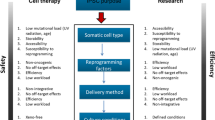Abstract
In the past ten years, great breakthroughs have been achieved in the nuclear reprogramming area. It has been demonstrated that highly differentiated somatic cell genome could be reprogrammed to a pluripotent state, which indicates that differentiated cell fate is not irreversible. Nuclear transplantation and induced pluripotent stem (iPS) cell generation are the two major approaches to inducing reprogramming of differentiated somatic cell genome. In the present review, we will summarize the recent progress of nuclear reprogramming and further discuss the potential to generate patient specific pluripotent stem cells from differentiated somatic cells for therapeutic purpose.
Similar content being viewed by others
References
Wilmut I, Schnieke A E, McWhir J, et al. Viable offspring derived from fetal and adult mammalian cells. Nature, 1997, 385(6619): 810–813
Munsie M J, Michalska A E, O’Brien C M, et al. Isolation of pluripotent embryonic stem cells from reprogrammed adult mouse somatic cell nuclei. Curr Biol, 2000, 11(16): 989–992
Wakayama T, Tabar V, Rodriguez I, et al. Differentiation of embryonic stem cell lines generated from adult somatic cells by nuclear transfer. Science, 2001, 292(5517): 740–743
Byrne J A, Pedersen D A, Clepper L L, et al. Producing primate embryonic stem cells by somatic cell nuclear transfer. Nature, 2007, 450(7169): 497–502
Takahashi K, Yamanaka S. Induction of pluripotent stem cells from mouse embryonic and adult fibroblast cultures by defined factors. Cell, 2006, 126(4): 663–676
Okita K, Ichisaka T, Yamanaka S. Generation of germline-competent induced pluripotent stem cells. Nature, 2007, 448(7151): 313–317
Wernig M, Meissner A, Foreman R, et al. In vitro reprogramming of fibroblasts into a pluripotent ES-cell-like state. Nature, 2007, 448(7151): 318–324
Takahashi K, Tanabe K, Ohnuki M, et al. Induction of pluripotent stem cells from adult human fibroblasts by defined factors. Cell, 2007, 131(5): 861–72
Yu J, Vodyanik M A, Smuga-Otto K, Antosiewicz-Bourget J, et al. Induced pluripotent stem cell lines derived from human somatic cells. Science, 2007, 318(5858): 1917–1920
Park I H, Zhao R, West J A, et al. Reprogramming of human somatic cells to pluripotency with defined factors. Nature, 2008, 451(7175): 141–146
Briggs R, King T J. Transplantation of living nuclei from blastula cells into enucleated frogs’ eggs. Proc Natl Acad Sci USA, 1952, 38(5): 455–463
McGrath J, Solter D. Nuclear transplantation in the mouse embryo by microsurgery and cell fusion. Science, 1983, 220(4603): 1300–1302
Evans M J, Kaufman M H. Establishment in culture of pluripotential cells from mouse embryos. Nature, 1981, 292(9): 154–156
Martin G R. Isolation of a pluripotent cell line from early mouse embryos cultured in medium conditioned by teratocarcinoma stem cells. Proc Natl Acad Sci USA, 1981, 78: 7634–7638
Thomson J A, Itskovitz-Eldor J, Shapiro S S, et al. Embryonic stem cell lines derived from human blastocysts. Science, 1998, 282(5391): 1145–1147
Hochedlinger K, Jaenisch R. Nuclear transplantation, embryonic stem cells, and potential for cell therapy. N Engl J Med, 2003, 349: 275–286
Yang X, Smith S L, Tian X C, et al. Nuclear reprogramming of cloned embryos and its implications for therapeutic cloning. Nat Gent, 2007, 39: 295–302
Egli D, Rosains J, Birkhoff G, et al. Developmental reprogramming after chromosome transfer into mitotic mouse zygotes. Nature, 2007, 447: 679–685
Greda P, Karasiewicz J, Modlinski J A. Mouse zygotes as recipients in embryo cloning. Reproduction, 2006, 132: 741–748
Meissner A, Wernig M, Jaenisch R. Direct reprogramming of genetically unmodified fibroblasts into pluripotent stem cells. Nat Biotechnol, 2007, 25(10): 1177–1181
Brambrink T, Foreman R, Welstead G G, et al. Sequential expression of pluripotency markers during direct reprogramming of mouse somatic cells. Cell Stem Cell, 2008, 2(2): 151–159
Stadtfeld M, Maherali N, Breault D T, et al. Defining molecular cornerstones during fibroblast to iPS cell reprogramming in mouse. Cell Stem Cell, 2008, 2(3): 230–240
Mikkelsen T S, Hanna J, Zhang X, Ku M et al. Dissecting direct reprogramming through integrative genomic analysis. Nature, 2008, 454(7200): 49–55
Park I H, Arora N, Huo H, et al. Disease-specific induced pluripotent stem cells. Cell, 2008, 134(5): 877–886
Dimos J T, Rodolfa K T, Niakan K K, Weisenthal L M, et al. Induced pluripotent stem cells generated from patients with ALS can be differentiated into motor neurons. Science. 2008, 321(5893): 1218–1221
Boiani M, Eckardt S, Scholer H R, et al. Oct4 distribution and level in mouse clones: Consequences for pluripotency. Genes Dev, 2002, 16: 1209–1219
Rideout W M3rd, Hochedlinger K, Kyba M, et al. Correction of a genetic defect by nuclear transplantation and combined cell and gene therapy. Cell, 2002, 109(1): 17–27
Kim J B, Zaehres H, Wu G, et al. Pluripotent stem cells induced from adult neural stem cells by reprogramming with two factors. Nature, 2008, 454(7204): 646–650
Shi Y, Do J T, Desponts C, et al. A combined chemical and genetic approach for the generation of induced pluripotent stem cells. Cell Stem Cell, 2008, 2(6): 525–528
Hochedlinger K, Yamada Y, Beard C, et al. Ectopic expression of Oct-4 blocks progenitor-cell differentiation and causes dysplasia in epithelial tissues. Cell, 2005, 121: 465–477
Author information
Authors and Affiliations
Corresponding author
Additional information
Supported by the National High Technology Research and Development Program of China (Grant No. 2005AA210930)
About this article
Cite this article
Wang, Y., Liu, S., Lai, L. et al. Nuclear reprogramming by nuclear transplantation and defined transcription factors. Chin. Sci. Bull. 54, 14–18 (2009). https://doi.org/10.1007/s11434-008-0576-y
Received:
Accepted:
Published:
Issue Date:
DOI: https://doi.org/10.1007/s11434-008-0576-y




